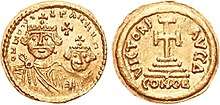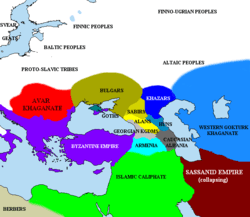Pannonian Avars
The Pannonian Avars (/ˈævɑːrz/; also known as the Obri in chronicles of Rus, the Abaroi or Varchonitai[9] Greek: Βαρχονίτες, romanized: Varchonítes, or Pseudo-Avars[10] in Byzantine sources, the Apar, Old Turkic: 𐰯𐰺, to the Göktürks[11]) were an alliance of several groups of Eurasian nomads of unknown origins.[12][13][14][15][16][17]
Pannonian Avars | |||||||||||||||
|---|---|---|---|---|---|---|---|---|---|---|---|---|---|---|---|
| 567 – after 822[1] | |||||||||||||||
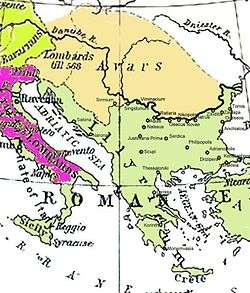 Avar Khaganate around 582–612 AD. | |||||||||||||||
| Common languages |
| ||||||||||||||
| Religion | Originally shamanism and animism, Christianity after 796 | ||||||||||||||
| Government | Khanate | ||||||||||||||
| Khagan | |||||||||||||||
| History | |||||||||||||||
• Established | 567 | ||||||||||||||
• Defeated by Pepin of Italy | 796 | ||||||||||||||
• Disestablished | after 822[7] | ||||||||||||||
| |||||||||||||||
They are probably best known for their invasions and destruction in the Avar–Byzantine wars from 568 to 626.
The name Pannonian Avars (after the area in which they eventually settled) is used to distinguish them from the Avars of the Caucasus, a separate people with whom the Pannonian Avars might or might not have had links.
They established the Avar Khaganate, which spanned the Pannonian Basin and considerable areas of Central and Eastern Europe from the late 6th to the early 9th century.[18]
Although the name Avar first appeared in the mid-5th century, the Pannonian Avars entered the historical scene in the mid-6th century,[19] on the Pontic-Caspian steppe as a people who wished to escape the rule of the Göktürks.
Origins
Avars and pseudo-Avars
The earliest clear reference to the Avar ethnonym comes from Priscus the Rhetor (died after 472 AD). Priscus recounts that, c. 463, the Šaragurs, Onogurs and Ogurs were attacked by the Sabirs, who had been attacked by the Avars. In turn, the Avars had been driven off by people fleeing "man-eating griffins" coming from "the ocean" (Priscus Fr 40).[20] Whilst Priscus' accounts provide some information about the ethno-political situation in the Don-Kuban-Volga region after the demise of the Huns, no unequivocal conclusions can be reached. Denis Sinor has argued that whoever the "Avars" referred to by Priscus were, they differed from the Avars who appear a century later, during the time of Justinian (who reigned from 527 to 565).[21]
The next author to discuss the Avars, Menander Protector, appeared during the 6th century, and wrote of Göktürk embassies to Constantinople in 565 and 568 AD. The Turks appeared angry at the Byzantines for having made an alliance with the Avars, whom the Turks saw as their subjects and slaves. Turxanthos, a Turk prince, calls the Avars "Varchonites" and "escaped slaves of the Turks", who numbered "about 20 thousand" (Menander Fr 43).[22]
Many more, but somewhat confusing, details come from Theophylact Simocatta, who wrote c. 629, describing the final two decades of the 6th century. In particular, he claims to quote a triumph letter from the Turk lord Tamgan:
For this very Chagan had in fact outfought the leader of the nation of the Abdali (I mean indeed, of the Hephthalites, as they are called), conquered him, and assumed the rule of the nation.
Then he ... enslaved the Avar nation.
But let no one think that we are distorting the history of these times because he supposes that the Avars are those barbarians neighbouring on Europe and Pannonia, and that their arrival was prior to the times of the emperor Maurice. For it is by a misnomer that the barbarians on the Ister have assumed the appellation of Avars; the origin of their race will shortly be revealed.
So, when the Avars had been defeated (for we are returning to the account) some of them made their escape to those who inhabit Taugast. Taugast is a famous city, which is a total of one thousand five hundred miles distant from those who are called Turks, ... Others of the Avars, who declined to humbler fortune because of their defeat, came to those who are called Moukri; this nation is the closest neighbour to the men of Taugast;
Then the Chagan embarked on yet another enterprise, and subdued all the Ogur, which is one of the strongest tribes on account of its large population and its armed training for war. These make their habitations in the east, by the course of the river Til, which Turks are accustomed to call Melas. The earliest leaders of this nation were named Var and Chunni; from them some parts of those nations were also accorded their nomenclature, being called Var and Chunni.
Then, while the emperor Justinian was in possession of the royal power, a small section of these Var and Chunni fled from that ancestral tribe and settled in Europe. These named themselves Avars and glorified their leader with the appellation of Chagan. Let us declare, without departing in the least from the truth, how the means of changing their name came to them. ...
When the Barsils, Onogurs, Sabirs, and other Hun nations in addition to these, saw that a section of those who were still Var and Chunni had fled to their regions, they plunged into extreme panic, since they suspected that the settlers were Avars. For this reason they honoured the fugitives with splendid gifts and supposed that they received from them security in exchange.
Then, after the Var and Chunni saw the well-omened beginning to their flight, they appropriated the ambassadors' error and named themselves Avars: for among the Scythian nations that of the Avars is said to be the most adept tribe. In point of fact even up to our present times the Pseudo-Avars (for it is more correct to refer to them thus) are divided in their ancestry, some bearing the time-honoured name of Var while others are called Chunni.
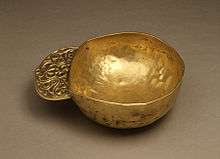
According to the interpretation of Dobrovits and Nechaeva, the Turks insisted that the Avars were only "pseudo-Avars", so as to boast that they were the only formidable power in the Eurasian steppe. The Göktürks claimed that the "real Avars" remained loyal subjects of the Turks, farther east.[21][23]
Furthermore, Dobrovits has questioned the authenticity of Theophylact's account. As such, he has argued that Theophylact borrowed information from Menander's accounts of Byzantine–Turk negotiations to meet political needs of his time – i.e. to castigate and deride the Avars during a time of strained political relations between the Byzantines and Avars (coinciding with Emperor Maurice's northern Balkan campaigns).[21]
Uar, Rouran and other Central Asian peoples
According to some scholars the Pannonian Avars originated from a confederation formed in the Aral Sea region, by the Uar, also known as the Var or Warr (who were probably a Uralic people) and the Xūn or Xionites (also known as the Chionitae, Chunni, Hunni, Yun and similar names);[24][25] the Xionites were maybe Iranian or Turkic-speaking or both.[26] A third tribe affiliated previously to the Uar and Xionites, the Hephthalites, had remained in Central and northern South Asia. In some transliterations, the term Var is rendered Hua, which is an alternate Chinese term for the Hephthalites. (While one of the cities most significant to the Hephthalites was Walwalij or Varvaliz, this may also be an Iranian term for "upper fortress".[27]) The Pannonian Avars were also known by names including Uarkhon or Varchonites – which may have been portmanteau words combining Var and Chunni.
The 18th-century historian Joseph de Guignes postulated a link between the Avars of European history with the Rouran Khaganate of Inner Asia based on a coincidence between Tardan Khan's letter to Constantinople and events recorded in Chinese sources, notably the Wei Shu and Bei Shi.[27] Chinese sources state that Bumin Qaghan, founder of the First Turkic Khaganate, defeated the Rouran, some of whom fled and joined the Western Wei. Later, Bumin's successor Muqan Qaghan defeated the Hephthalites as well as the Turkic Tiele. Superficially these victories over the Tiele, Rouran and Hephthalites echo a narrative in the Theophylact, boasting of Tardan's victories over the Hephthalites, Avars and Oghurs. However, the two series of events are not synonymous: the events of the latter took place during Tardan's rule, c. 580–599, whilst Chinese sources referring to the Turk defeat of the Rouran and other Central Asian peoples occurred 50 years earlier, at the founding of the First Turkic Khaganate. It is for this reason that the linguist János Harmatta rejects the identification of the Avars with the Rouran.
According to Edwin G. Pulleyblank, the name Avar is the same as the prestigious name Wuhuan in the Chinese sources.[28]
Several historians, including Peter Benjamin Golden, suggest that the Avars are of Turkic origin, likely from the Oghur branch.[29] Another theory suggests that some of the Avars were of Tungusic origin.[30]
A study by Emil Heršak and Ana Silić suggests that the Avars were of heterogeneous origin, including mostly Turkic (Oghuric) and Mongolic groups. Later in Europe some Germanic and Slavic groups were assimilated into the Avars. They concluded that their exact origin is unknown but state that it is likely that the Avars were originally mainly composed of Turkic (Oghuric) tribes.[31]
Steppe empire dynamics and ethnogenesis
In 2003, Walter Pohl summarized the formation of nomadic empires:[32]
1. Many steppe empires were founded by groups who had been defeated in previous power struggles but had fled from the dominion of the stronger group. The Avars were likely a losing faction previously subordinate to the (legitimate) Ashina clan in the Western Turkic Khaganate, and they fled west of the Dnieper.
2. These groups usually were of mixed origin, and each of its components was part of a previous group.
3. Crucial in the process was the elevation of a khagan, which signified a claim to independent power and an expansionist strategy. This group also needed a new name that would give all of its initial followers a sense of identity.
4. The name for a new group of steppe riders was often taken from a repertoire of prestigious names which did not necessarily denote any direct affiliation to or descent from groups of the same name; in the Early Middle Ages, Huns, Avars, Bulgars, and Ogurs, or names connected with -(o)gur (Kutrigurs, Utigurs, Onogurs, etc.), were most important. In the process of name-giving, both perceptions by outsiders and self-designation played a role. These names were also connected with prestigious traditions that directly expressed political pretensions and programmes, and had to be endorsed by success. In the world of the steppe, where agglomerations of groups were rather fluid, it was vital to know how to deal with a newly-emergent power. The symbolical hierarchy of prestige expressed through names provided some orientation for friend and foe alike.
Such views are mirrored by Csanád Bálint. "The ethnogenesis of early medieval peoples of steppe origin cannot be conceived in a single linear fashion due to their great and constant mobility", with no ethnogenetic "point zero", theoretical "proto-people" or proto-language.[33]
Moreover, Avar identity was strongly linked to Avar political institutions. Groups who rebelled or fled from the Avar realm could never be called "Avars", but were rather termed "Bulgars". Similarly, with the final demise of Avar power in the early 9th century, Avar identity disappeared almost instantaneously.[34]
History
Arrival in Europe
In 557 the Avars sent an embassy to Constantinople — presumably from the northern Caucasus. This marked their first contact with the Byzantine Empire. In exchange for gold, they agreed to subjugate the "unruly gentes" on behalf of the Byzantines: subsequently they conquered and incorporated various nomadic tribes—Kutrigurs and Sabirs—and defeated the Antes.[35] By 562 the Avars controlled the lower Danube basin and the steppes north of the Black Sea.[36] By the time they arrived in the Balkans, the Avars formed a heterogeneous group of about 20,000 horsemen.[37] After the Byzantine Emperor Justinian I (reigned 527–565) bought them off, they pushed northwestwards into Germania. However, Frankish opposition halted the Avars' expansion in that direction.
Seeking rich pastoral lands, the Avars initially demanded land south of the Danube River in present-day Bulgaria, but the Byzantines refused, using their contacts with the Göktürks as a threat against Avar aggression.[38] The Avars turned their attention to the Carpathian Plain and to the natural defenses it afforded.[39] However, the Carpathian basin was then occupied by the Gepids. In 567 the Avars formed an alliance with the Lombards—enemies of the Gepids—and together they destroyed much of the Gepid Kingdom. The Avars then persuaded the Lombards to move into northern Italy, an invasion that marked the last Germanic mass-movement in the Migration Period.
Continuing their successful policy of turning the various barbarians against each other, the Byzantines persuaded the Avars to attack the Sclavenes in Scythia Minor (modern Dobruja), a land rich with goods.[37] After devastating much of the Sclavenes' land, the Avars returned to Pannonia after many of the Khagan's subjects deserted to the Byzantine Emperor.
Early Avar Period (580–670)
.jpg)
By about 580, the Avar Khagan Bayan I had established supremacy over most of the Slavic, Bulgar and Germanic tribes living in Pannonia and the Carpathian Basin.[40] When the Byzantine Empire was unable to pay subsidies or hire Avar mercenaries, the Avars raided their Balkan territories. According to Menander, Bayan commanded an army of 10,000 Kutrigur Bulgars and sacked Dalmatia in 568, effectively cutting the Byzantine terrestrial link with North Italy and Western Europe. By 582, the Avars had captured Sirmium, an important fort in Pannonia. When the Byzantines refused to increase the stipend amount as requested by Bayan's son and successor Bayan II (from 584), the Avars proceeded to capture Singidunum and Viminacium. They suffered setbacks, however, during Maurice's Balkan campaigns in the 590s.
By 600 the Avars had established a nomadic empire ruling over a multitude of peoples and stretching from modern Austria in the west to the Pontic–Caspian steppe in the east. After being defeated at the Battles of Viminacium in their homeland, some Avars defected to the Byzantines in 602 but Emperor Maurice decided not to return home as was customary.[41] He maintained his army camp beyond the Danube throughout the winter but the hardship caused the army to revolt, giving the Avars a desperately needed respite and they attempted an invasion of northern Italy in 610. The Byzantine civil war prompted a Persian invasion in the Byzantine–Sasanian War of 602–628 and after 615, the Avars enjoyed a free hand in the undefended Balkans.
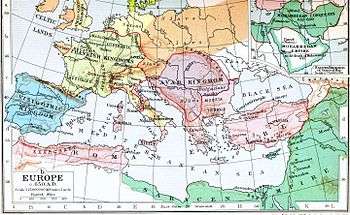
While negotiating with Emperor Heraclius beneath the walls of Constantinople in 617, the Avars launched a surprise attack. While they were unable to capture the city centre they pillaged the suburbs of the city and took 270,000 captives. Payments in gold and goods to the Avars reached the record sum of 200,000 solidi shortly before 626.[42] In 626, the Avars cooperated with the Sassanid force in the failed siege of 626. Following this defeat, the political and military power of the Avars declined. Byzantine and Frankish sources documented a war between the Avars and their western Slav clients, the Wends.[37]
Each year, the Huns [Avars] came to the Slavs, to spend the winter with them; then they took the wives and daughters of the Slavs and slept with them, and among the other mistreatments [already mentioned] the Slavs were also forced to pay levies to the Huns. But the sons of the Huns, who were [then] raised with the wives and daughters of these Wends could not finally endure this oppression anymore and refused obedience to the Huns and began, as already mentioned, a rebellion. When now the Wendish army went against the Huns, the [aforementioned] merchant Samo accompanied the same. And so the Samo’s bravery proved itself in wonderful ways and a huge mass of Huns fell to the sword of the Wends.
In the 630s, Samo, the ruler of the first historically known Slavic polity known as Samo's Tribal Union or Samo's realm, increased his authority over lands to the north and west of the Khaganate at the expense of the Avars, ruling until his death in 658.[43]
The Chronicle of Fredegar recorded that during Samo's rebellion in 631AD, 9,000 Bulgars led by Alciocus left Pannonia to modern-day Bavaria where Dagobert I massacred most of them. The remaining 700 joined the Wends. At about the time of Samo's realm, the Kubrat of the Dulo clan led a successful uprising to end Avar authority over the Pannonian Plain; he established Old Great Bulgaria, or Patria Onoguria, "the homeland of Onogurs". The civil war, possibly a succession struggle in Onoguria between the joint Kutrigur and Utigur forces, raged from 631 to 632. The power of the Avars' Kutrigur forces was shattered and the Avars came under the control of Great Bulgaria. At the same time, according to Constantine VII's work De Administrando Imperio (10th century), a group of Croats separated from the White Croats who lived in White Croatia and arrived by their own will, or were called by the Byzantine Emperor Heraclius (610-641), to fight and defeat the Avars after which they eventually organized their own principality in Dalmatia.[44]
Middle (670–720) and Late (720–804) Avar periods
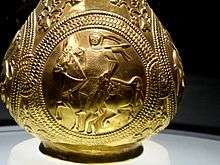
With the death of Samo, some Slavic tribes again came under Avar rule. The Bulgar Khan Kubrat died in 665 and was succeeded by Khan Batbayan of Old Great Bulgaria. By 670, the Viennese chronicle records that in 677, the "Ungri" (Onogur Bulgar) ethnicon was established decisively in Pannonia.
Following Khan Kubrat's death or a few years later in the time of Bezmer, the empire was dissolved into 5 branches. Two of them (led by Batbayan and Kotrag) were subdued by the emerging Khazar Empire, while the fourth one led by Asparukh established the Danube Bulgar Empire and stabilized it by the victory at the battle of Ongal. The fourth folk moved to Ravenna while the fifth one, led by Kuber moved into the Avar Khaganate. According to the Miracles of Saint Demetrius the Avar-Slavic alliance from northern Carpathia forced the Bulgars south out of western Onoguria (Sirmium) at about the same time that the Battle of Ongal took place south of the eastern Carpathians. The new ethnic element marked by hair clips for pigtails; curved, single-edged sabres; broad, symmetrical bows marks the middle Avar-Bulgar period (670–720). The Onogur Bulgars under a Kuber leader expelled from western Onoguria (Sirmium) moved south, settling in the present-day region of Macedonia. The Onogur-Bulgars, led by Khan Asparukh—the father of Khan Tervel—settled permanently along the Danube (c. 679–681), expanding the First Bulgarian Empire from Onogur, Bulgaria. Although the Avar empire had diminished to half its original size, the new Avar-Slav alliance consolidated their rule west from the central parts of the mid-Danubian basin and extended their sphere of influence west to the Viennese Basin. New regional centers, such as those near Ozora and Igar—county Fehér in Hungary—appeared. This strengthened the Avars' power base, although most of the Balkans now lay in the hands of Slavic tribes since neither the Avars nor Byzantines were able to reassert control.
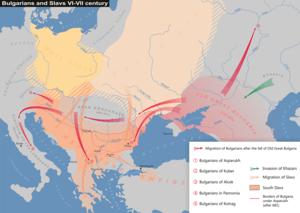
A new type of ceramics—the so-called "Devínska Nová Ves" pottery—emerged at the end of the 7th century in the region between the Middle Danube and the Carpathians.[45] These vessels were similar to the hand-made pottery of the previous period, but wheel-made items were also found in Devínska Nová Ves sites.[45] Large inhumation cemeteries found at Holiare, Nové Zámky and other places in Slovakia, Hungary and Serbia from the period beginning around 690 show that the settlement network of the Carpathian Basin became more stable in the Late Avar period.[46][47] The most popular Late Avar motifs—griffins and tendrils decorating belts, mounts and a number of other artifacts connected to warriors—may either represent nostalgia for the lost nomadic past or evidence a new wave of nomads arriving from the Pontic steppes at the end of the 7th century.[46][48] According to historians who accept the latter theory, the immigrants may have been either Onogurs[49] or Alans.[50] Anthropological studies of the skeletons point at the presence of a population with mongoloid features.[46]
The Khaganate in the Middle and Late periods was a product of cultural symbiosis between Slavic and original Avar elements with a Slavic language as a lingua franca or the most common language.[51]
In the 7th century, the Avar Khaganate opened a door for Slavic demographic and linguistic expansion to Adriatic and Aegean regions.
In the early 8th century, a new archaeological culture—the so-called "griffin and tendril" culture—appeared in the Carpathian basin. Some theories, including the "double conquest" theory of archaeologist Gyula László, attribute it to the arrival of new settlers, such as early Magyars, but this is still under debate. Hungarian archaeologists Laszló Makkai and András Mócsy attribute this culture to an internal evolution of Avars resulting from the integration of the Bulgar émigrés from the previous generation of the 670s. According to Makkai and Mócsy, "the material culture—art, clothing, equipment, weapons—of the late Avar/Bulgar period evolved autonomously from these new foundations". Many regions that had once been important centers of the Avar empire had lost their significance while new ones arose. Although Avaric material culture found over much of the northern Balkans may indicate an existing Avar presence, it probably represents the presence of independent Slavs who had adopted Avaric customs.[52]
Collapse
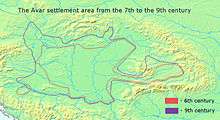
The gradual decline of Avar power accelerated to a rapid fall within a decade. A series of Frankish campaigns in the 790s, beginning in 791, ended with the conquest of the Avar realm after eight years. The 791 campaign ended successfully, although no pitched battle was fought.[53] Avars had fled before the Carolingian army arriving by the Danube, while disease left most of the Avar horses dead.[53] Tribal infighting began, showing the weakness of the khaganate.[53] The Franks had been supported by Slavs, who established polities on former Avar territory.[54] One of Charlemagne's sons captured a large, fortified encampment known as "the Ring", which contained much of the spoils from earlier Avar campaigns.[55] The campaign against the Avars again gathered momentum. It would take two massive hammer-blows, two major musters of the host, drawing upon levies from every part of the now great kingdom, before the robbers' nest was exterminated. And at last, in the year 796, five years after the war began, the Avars cracked and lay utterly at the king's mercy.[56]
By 796, the Avar chieftains had surrendered and accepted Christianity.[53] Pannonia was conquered.[57] According to the Annales Regni Francorum, Avars began to submit to the Franks from 796 onwards. The song "De Pippini regis Victoria Avarica" celebrating the defeat of the Avars at the hands of Pepin of Italy in 796 still survives. The Franks baptized many Avars and integrated them into the Frankish Empire.[58] A growing amount of archaeological evidence in Transdanubia also suggests an Avar population in the Carpathian Basin in the very late 9th century.[59] In 799, some Avars revolted.[60]
In 804, the Bulgaria conquered the southeastern Avar lands of Transylvania and southeastern Pannonia up to the Middle Danube River, and many Avars became subjects of the Bulgarian Empire. Khagan Theodorus, a convert to Christianity, died after asking Charlemagne for help in 805; he was succeeded by Khagan Abraham, who was baptized as the new Frankish client (and should not be assumed from his name alone to have been Khavar rather than Pseudo-Avar). Abraham was succeeded by Khagan (or Tudun) Isaac (Latin Canizauci), about whom little is known. The Franks turned the Avar lands under their control into a military march. The March of Pannonia—the eastern half of the Avar March—was then granted to the Slavic Prince Pribina, who established the Balaton principality in 840. It continued to exist in the west until it was divided between the Carinthian and Eastern marches in 871.
Whatever was left of Avar power was effectively ended when the Bulgars expanded their territory into the central and eastern portions of traditional Avar lands around 829.[61] According to Pohl, an Avar presence in Pannonia is certain in 871, but thereafter the name is no longer used by chroniclers. Pohl wrote, "It simply proved impossible to keep up an Avar identity after Avar institutions and the high claims of their tradition had failed".[62] Although, Regino wrote about them at the year of 889.[59][63] The growing number of archaeological evidence in Transdanubia also presumes an Avar population in the Carpathian Basin in the very late 9th century.[59] Archaeological findings suggest a substantial, late Avar presence on the Great Hungarian Plain, however it is difficult to determine their proper chronology.[59] The preliminary results of the new excavations also imply that the known and largely accepted theory of the destruction of the Avar settlement area is outdated, the disastrous depopulation of the Avar Khaganate has never happened.[64]
Byzantine records, including the "Notitia episcopatuumî", the "Additio patriarchicorum thronorumî" by Neilos Doxopatres, the "Chronica" by Petrus Alexandrinus and the "Notitia patriarchatuum" mention the 9th century Avars as an existing Christian population.[59] The Avars had already been mixing with the more numerous Slavs for generations, and they later came under the rule of external polities, such as the Franks, Bulgaria, and Great Moravia.[65] The Avars in the region known as solitudo avarorum—currently called the Alföld—vanished in an arc of three generations. They slowly merged with the Slavs to create a bilingual Turkic-Slavic-speaking people who were subjected to Frankish domination; the invading Magyars found this composite people in the late 9th century.[66] The De Administrando Imperio, written around 950, clearly states the presence of an Avar population in the region of modern-day Croatia.[59]
There has been speculation that the modern Avar people of the Caucasus might have an uncertain connection to the historical Avars but direct descent from them is rejected or doubted by many scholars.[61]
Anthropological evidence
In contemporary art, Avars were sometimes depicted as mounted archers, riding backwards on their horses.[67]
According to mid-20th Century physical anthropologists such as Pál Lipták, human remains from the early Avar (7th century) period had mostly "Europoid" features, while grave goods indicated cultural links to the Eurasian steppe.[68]
Cemeteries dated to the late Avar period (8th century) included many human remains with physical features typical of East Asian people or Eurasians (i.e., people with both East Asian and European ancestry).[69] Remains with East Asian or Eurasian features were found in about one third of the Avar graves from the 8th Century.[70] According to Lipták, 79% of the population of the Danube-Tisza region during the Avar period showed Europoid characteristics.[68] (Lipták used racial terms later deprecated or regarded as obsolete, such as "Mongoloid" for North East Asian and "Turanid" for individuals of mixed ancestry.[71])
Several theories suggest that the ruling class of the Avars were of Tungusic East Asian origin or of partially Tungusic origin.[30]
Social and tribal structure
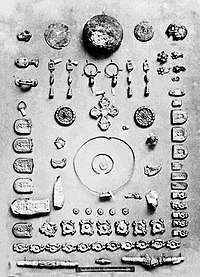
The Pannonian Basin was the centre of the Avar power-base. The Avars re-settled captives from the peripheries of their empire to more central regions. Avar material culture is found south to Macedonia. However, to the east of the Carpathians, there are next to no Avar archaeological finds, suggesting that they lived mainly in the western Balkans. Scholars propose that a highly structured and hierarchical Avar society existed, having complex interactions with other "barbarian" groups. The khagan was the paramount figure, surrounded by a minority of nomadic aristocracy.
A few exceptionally rich burials have been uncovered, confirming that power was limited to the khagan and a close-knit class of "elite warriors". In addition to hoards of gold coins that accompanied the burials, the men were often buried with symbols of rank, such as decorated belts, weapons, stirrups resembling those found in central Asia, as well as their horse. The Avar army was composed from numerous other groups: Slavic, Gepidic and Bulgar military units. There also appeared to have existed semi-independent "client" (predominantly Slavic) tribes which served strategic roles, such as engaging in diversionary attacks and guarding the Avars' western borders abutting the Frankish Empire.
Initially, the Avars and their subjects lived separately, except for Slavic and Germanic women who married Avar men. Eventually, the Germanic and Slavic peoples were included in the Avaric social order and culture, itself Persian-Byzantine in fashion.[72] Scholars have identified a fused, Avar-Slavic culture, characterized by ornaments such as half-moon-shaped earrings, Byzantine-styled buckles, beads, and bracelets with horn-shaped ends.[72] Paul Fouracre notes, "[T]here appears in the seventh century a mixed Slavic-Avar material culture, interpreted as peaceful and harmonious relationships between Avar warriors and Slavic peasants. It is thought possible that at least some of the leaders of the Slavic tribes could have become part of the Avar aristocracy".[73] Apart from the assimilated Gepids, a few graves of west Germanic (Carolingian) peoples have been found in the Avar lands. They perhaps served as mercenaries.[72]
Each year, the Huns [Avars] came to the Slavs, to spend the winter with them; then they took the wives and daughters of the Slavs and slept with them, and among the other mistreatments [already mentioned] the Slavs were also forced to pay levies to the Huns. But the sons of the Huns, who were [then] raised with the wives and daughters of these Wends [Slavs] could not finally endure this oppression anymore and refused obedience to the Huns and began, as already mentioned, a rebellion.
— Chronicle of Fredegar, Book IV, Section 48, written circa 642
Language
The language or languages spoken by the Avars are unknown.[12][14][15][16] Classical philologist Samuel Szadeczky-Kardoss states that most of the Avar words used in contemporaneous Latin or Greek texts appear to have their origins in possibly Mongolian or Turkic languages.[74][75] Other theories propose a Tungusic origin.[76] According to Szadeczky-Kardoss, many of the titles and ranks used by the Pannonian Avars were also used by the Turks, Proto-Bulgars, Uighurs and/or Mongols, including khagan (or kagan), khan, kapkhan, tudun, tarkhan, and khatun.[75] There is also evidence, however, that ruling and subject clans spoke a variety of languages. Proposals by scholars include Caucasian,[14] Iranian,[3] Tungusic,[77][78][79] Hungarian[80] and Turkic.[9][81] A few scholars speculated that Proto-Slavic became the lingua franca of the Avar Khaganate.[82] Historian Gyula László has suggested that the late 9th century Pannonian Avars spoke a variety of Old Hungarian, thereby forming an Avar-Hungarian continuity with then-newly arrived Hungarians.[83]
Gyula László's Avar-Hungarian continuity theory
Gyula László suggests that late Avars, arriving to the khaganate in 670 in great numbers, lived through the time between the destruction and plunder of the Avar state by the Franks during 791–795 and the arrival of the Magyars in 895. László points out that the settlements of the Hungarians (Magyars) complemented, rather than replaced, those of the Avars. Avars remained on the plough fields, good for agriculture, while Hungarians took the river banks and river flats, suitable for pasturage. He also notes that while the Hungarian graveyards consist of 40–50 graves on average, those of the Avars contain 600–1000. According to these findings, the Avars not only survived the end of the Avar polity but lived in great masses and far outnumbered the Hungarian conquerors of Árpád. He also shows that Hungarians occupied only the centre of the Carpathian basin, but Avars lived in a larger territory. Looking at those territories where only the Avars lived, one only finds Hungarian geographical names, not Slavic or Turkic as would be expected interspersed among them. This is further evidence for the Avar-Hungarian continuity. Names of the Hungarian tribes, chieftains and the words used for the leaders, etc., suggest that at least the leaders of the Hungarian conquerors were Turkic speaking. However, Hungarian is not a Turkic language, rather Finno-Ugric, and so they must have been assimilated by the Avars that outnumbered them and the genetics of today's modern Hungarians is no different than that of neighboring West Slavs as well as western Ukrainians. László's Avar-Hungarian continuity theory also states that the modern Hungarian language descends from that spoken by the Avars rather than the conquering Magyars.[84][85] László's research does suggest, at the very least, that it is likely that any remaining Avars in the Carpathian Basin who resisted Slavic assimilation were absorbed by the invading Magyars and lost their identity.
See also
Notes
Citations
- Carl Waldman & Catherine Mason, 2006, Encyclopedia of European Peoples, Volume 2, New York: Infobase Publishing, p. 769.
- Curta, Florin (2004). "The Slavic lingua franca (Linguistic Notes of an Archeologist Turned Historian)" (PDF). East Central Europe/L'Europe du Centre-Est. 31 (1): 132.
- Curta, Florin (2004). "The Slavic lingua franca (Linguistic notes of an archaeologist turned historian)". East Central Europe/L'Europe du Centre-Est. 31: 125–148. doi:10.1163/187633004X00134. Retrieved 29 May 2015.
By contrast, there is very little evidence that speakers of Slavic had any significant contact with Turkic. As a consequence, and since the latest stratum of loan words in Common Slavic is Iranian in origin, Johanna Nichols advanced the idea that the Avars spoke an Iranian, not a Turkic language.
- Helimski, E (2004). "Die Sprache(n) der Awaren: Die mandschu-tungusische Alternative". Proceedings of the First International Conference on Manchu-Tungus Studies, Vol. II: 59–72.
- Fuente, José Andrés Alonso de la. "Tungusic Historical Linguistics and the Buyla (a.k.a. Nagyszentmiklós) Inscription". academia.edu.
- Harmatta, János (1995). "Sogdian Inscriptions on Avar Objects". Acta Orientalia Academiae Scientarium Hung. XLVIII (1–2): 61–65. JSTOR 43391205.
- Carl Waldman & Catherine Mason, 2006, Encyclopedia of European Peoples, Volume 2, New York: Infobase Publishing, p. 769.
- CNG Coins
- Avars at the Encyclopedia of Ukraine
- According to Grousset, Empire of the Steppes, page 171, Theophylact Simocatta called them pseudo-Avars because he thought the true Avars were the Rouran.
- Archived 2018-06-24 at the Wayback Machine Apar - Avars were called "Apar".
- "Avar". Encyclopædia Britannica Online. Encyclopædia Britannica. Retrieved May 14, 2015.
Avar, one of a people of undetermined origin and language...
- Frassetto, Michael (1 January 2003). Encyclopedia of Barbarian Europe: Society in Transformation. ABC-CLIO. pp. 54–55. ISBN 978-1576072639. Retrieved 28 May 2015.
The exact origins of the Avars remain uncertain...
CS1 maint: ref=harv (link) - Waldman, Carl; Mason, Catherine (2006). Encyclopedia of European Peoples. Infobase Publishing. pp. 46–49. ISBN 978-1-4381-2918-1. Retrieved 5 May 2013.CS1 maint: ref=harv (link)
- Beckwith 2009, pp. 390–391: "... the Avars certainly contained peoples belonging to several different ethnolinguistic groups, so that attempts to identify them with one or another specific eastern people are misguided."
- Kyzlasov 1996, p. 322: "The Juan-Juan state was undoubtedly multi-ethnic, but there is no definite evidence as to their language... Some scholars link the Central Asian Juan-Juan with the Avars who came to Europe in the mid-sixth century. According to widespread but unproven and probably unjustified opinion, the Avars spoke a language of the Mongolic group."
- Pritsak (1983, p. 359)
- Walter Pohl, Die Awaren: ein Steppenvolk im Mitteleuropa, 567–822 n. Chr, C.H.Beck (2002), ISBN 978-3-406-48969-3, p. 26-29.
- Curta, Florin (2006). Southeastern Europe in the Middle Ages, 500–1250. Cambridge medieval textbooks. Cambridge: Cambridge University Press. ISBN 978-0-521-81539-0. Retrieved 2009-11-20.
- Maenchen-Helfen (1976, p. 436)
- Dobrovits (2003)
- Whitby (1986, p. 226, footnote 48)
- Nechaeva (2011)
- Гулямов Я. Г., История орошения Хорезма с древнейших времен до наших дней, Ташкент, 1957.
- Муратов Б.А. Аланы, кавары и хиониты в этногенезе башкир//Урал-Алтай: через века в будущее: Материалы Всероссийской научной конференции. Уфа, 27 июня 2008.
- Peter B. Golden, 2005 "Turks and Iranians: a cultural sketch", in: Lars Johanson and Christiane Bulut (ed.), Turkic-Iranian Contact Areas: Historical and Linguistic Aspects, Turcologica 62, Wiesbaden, p. 19.
- Harmatta (2001)
- The Peoples of the Steppe Frontier in Early Chinese Sources, Edwin G. Pulleyblank, pages 35, 44
- Golden, Peter B. An Introduction to the History of the Turkic Peoples.
- Helimski, E (2004). "Die Sprache(n) der Awaren: Die mandschu-tungusische Alternative". Proceedings of the First International Conference on Manchu-Tungus Studies, Vol. II: 59–72.
- Silić, Ana; Heršak, Emil (2002-09-30). "The Avars: A Review of Their Ethnogenesis and History". Migracijske I Etničke Teme (in Croatian). 18 (2–3): 197–224. ISSN 1333-2546.
- Pohl (2003, pp. 477–478)
- Balint (2010, p. 150)
- Pohl (1998)
-
Pohl, Walter (1998). "Conceptions of Ethnicity in Early Medieval Studies". In Little, Lester K.; Rosenwein, Barbara H. (eds.). Debating the Middle Ages: Issues and Readings. Blackwell Publishers. p. 18. Retrieved 2020-05-05.
[...] the first thing the Avars did when they came near the Caucasus on their flight from Central Asia was to send an embassy to the aging emperor Justinian. That took place sometime in winter 558/59, and they struck the usual deal: the Avars were to fight for the Empire against unruly gentes and in turn would receive annual payments and other benefits. Indeed, for 20 years to come the Avars, under their Khagan Baian, fought Utigurs and Antes, Gepids and Slavs, whereas their policy towards the Empire relied more on negotiation than on war.
- Walter Pohl, "Conceptions of Ethnicity in Early Medieval Studies", Debating the Middle Ages: Issues and Readings, ed. Lester K. Little and Barbara H. Rosenwein, (Blackwell), 1998, pp 13–24 p. 18 (On-line text).
- Curta 2001.
- Evans, James Allan Stewart (2005). The Emperor Justinian And The Byzantine Empire. Greenwood Guides to Historic Events of the Ancient World. Greenwood Publishing Group. p. xxxv. ISBN 978-0-313-32582-3. Retrieved 2013-01-24.
An Avar embassy first appeared in Constantinople in 558, asking for land within the empire and calling for an annual subsidy. Justinian granted them a subsidy, but for land he directed them elsewhere.
- History of Transylvania, Volume I. László Makkai, András Mócsy. Columbia University Press. 2001
- Pohl 1998:18.
- Walter Pohl, Die Awaren (Munich) 2.ed.2002., page 158.
- Walter Pohl, Die Awaren (Munich) 1.ed.1988.
- The fate of Samo's empire after his death is unclear; it is generally assumed to have disappeared. Archaeological findings show that the Avars returned to their previous territories—at least to southernmost part of present-day Slovakia—and entered into a symbiotic relationship with the Slavs, whereas to the north of the Avar empire was purely Wend territory. The first specific knowledge of the presence of Slavs and Avars in this area is the existence in the late 8th century of the Moravian and Nitrian principalities (see Great Moravia) that were attacking the Avars and the defeat of the Avars by the Franks under Charlemagne in 799 or 802–803.
- Georgios Kardaras, 2018, Byzantium and the Avars, 6th-9th Century AD, https://books.google.hr/books/about/Byzantium_and_the_Avars_6th_9th_Century.html?id=gwpwuQEACAAJ&redir_esc=y #page=94
- Barford 2001, p. 78.
- Barford 2001, p. 79.
- Curta 2006, pp. 92–93.
- Curta 2006, p. 92.
- Kristó 1996, p. 93.
- Havlík 2004, p. 228.
- Curta, Florin (2004), "The Slavic Lingua Franca. Linguistic Notes of an Archaeologist Turned Historian." (PDF), East Central Europe/L'Europe du Centre-Est 31 (1): 125–148,
- László Makkai and András Mócsy, editors, 2001. History of Transylvania, II.4 "The period of Avar rule"
- Schutz 2004, p. 61.
- Schutz 2004, pp. 61-62.
- Victor Duruy, The History of the Middle Ages, p. 446
- The Emperor Charlemagne, Russell Chamberlin, Sutton Publishing, 2004 pp.181 & 182
- Sinor 1990, pp. 218-220.
- ...(sc. Avaros) autem, qui obediebant fidei et baptismum sunt consecuti...
- OLAJOS , TERÉZ, Az avar továbbélés kérdésérõl Archived 2012-02-05 at the Wayback Machine, A 9. SZÁZADI AVAR TÖRTÉNELEM GÖRÖG ÉS LATIN NYELVÛ FORRÁSAI, Tiszatáj, 2001, pp. 50–56
- Schutz 2004, p. 62.
- Skutsch, Carl, ed. (2005). Encyclopedia of the World's Minorities. New York: Routledge. p. 158. ISBN 1-57958-468-3.
- Pohl 1998:19.
- "Et primo quidem Pannoniorum et Avarum solitudines pererrantes"
- Imperial Spheres and the Adriatic: Byzantium, the Carolingians and the Treaty of Aachen (812)
- The early medieval Balkans. John Fine, Jr
- András Róna-Tas, Hungarians and Europe in the early Middle Ages: an introduction to early Hungarian history, Central European University Press, 1999, p. 264
- Archivum Eurasiae Medii Aevi, Vol. 4. Otto Harrassowitz, 1984
- Erzsébet Fóthi, Anthropological conclusions of the study of Roman and Migration periods, Acta Biologica Szegediensis, Volume 44(1–4):87–94, 2000.
- "Acta archaeologica Academiae Scientiarum Hungaricae", Magyar Tudományos Akadémia, 1 Jan 1967, Page 86
- Russian Translation Series of the Peabody Museum of Archaeology ... – Page 21
- Lipták, Pál. Recherches anthropologiques sur les ossements avares des environs d'Üllö (1955) – In: Acta archaeologica Academiae Scientiarum Hungaricae, vol. 6 (1955), pp. 231–314
- History of Transylvania
- The New Cambridge Medieval History. Paul Fouracre
- http://www.uni-salzburg.at/fileadmin/oracle_file_imports/544328.PDF
- Szadeczky-Kardoss 1990, p. 221.
- "Helimski: Early European Avars were (in part) Tungusic speakers". SARKOBOROS. 2014-09-08. Retrieved 2017-08-05.
- Futaky, I. (2001). Nyelvtörténeti vizsgálatok a Kárpát-medencei avar-magyar kapcsolatok kérdéséhez. Mongol és mandzsu-tunguz elemek nyelvünkben (in Hungarian). Budapest.
- Helimski, Eugene (2000). "Язык(и) аваров: тунгусо-маньчжурский аспект". Folia Orientalia 36 (Festschrift for St. Stachowski) (in Russian). pp. 135–148.
- Helimski, Eugene (2000). "On probable Tungus-Manchurian origin of the Buyla inscription from Nagy-Szentmiklós (preliminary communication)". Studia Etymologica Cracoviensia (5): 43–56.
- "Kettős honfoglalás". Wikipédia (in Hungarian). 2016-11-12.
- Róna-Tas, András (1999-01-01). Hungarians and Europe in the Early Middle Ages: An Introduction to Early Hungarian History. Central European University Press. p. 116. ISBN 9789639116481.
- Curta, Florin (2004). "The Slavic lingua franca (Linguistic Notes of an Archeologist Turned Historian)" (PDF). East Central Europe/L'Europe du Centre-Est. 31 (1): 132–148.
- "História 1982-01|Digitális Tankönyvtár". www.tankonyvtar.hu (in Hungarian). Retrieved 2016-11-30.
- László, Gyula (1978). A "kettős honfoglalás". Budapest, Hungary: Magvető Könyvkiadó.
- "Documentary with Gyula László". Duna Television.
Sources
- Barford, P. M. (2001). The Early Slavs: Culture and Society in Early Medieval Eastern Europe. Cornell University Press. ISBN 0-8014-3977-9.CS1 maint: ref=harv (link)
- Beckwith, Christopher I. (16 March 2009). Empires of the Silk Road: A History of Central Eurasia from the Bronze Age to the Present. Princeton University Press. ISBN 978-0691135892. Retrieved 29 May 2015.CS1 maint: ref=harv (link)
- E. Breuer, "Chronological Studies to Early-Medieval Findings at the Danube Region. An Introduction to Byzantine Art at Barbaric Cemeteries." (Tettnang 2005).
- Csáky, Veronika; et al. (January 22, 2020). "Genetic insights into the social organisation of the Avar period elite in the 7th century AD Carpathian Basin". Scientific Reports. Nature Research. 10 (948): 948. Bibcode:2020NatSR..10..948C. doi:10.1038/s41598-019-57378-8. PMC 6976699. PMID 31969576.
- Curta, Florin (2001). The Making of the Slavs: History and Archaeology of the Lower Danube Region, c. 500–700. Cambridge: Cambridge University Press. ISBN 9781139428880.CS1 maint: ref=harv (link)
- Curta, Florin (2006). Southeastern Europe in the Middle Ages, 500–1250. Cambridge: Cambridge University Press. ISBN 9780521815390.CS1 maint: ref=harv (link)
- Evans, James Allan Stewart (2005). The Emperor Justinian And The Byzantine Empire. Greenwood Guides to Historic Events of the Ancient World. Greenwood Publishing Group. p. xxxv. ISBN 978-0-313-32582-3. Retrieved 2013-01-24.
- Dobrovits, Mihály (2003). ""They called themselves Avar" – Considering the pseudo-Avar question in the work of Theophylaktos". Ērān Ud Anērān Webfestschrift Marshak 2003.
- Fine, John Van Antwerp, Jr. (1991). The Early Medieval Balkans: A Critical Survey from the Sixth to the Late Twelfth Century. Michigan: The University of Michigan Press. ISBN 0-472-08149-7.CS1 maint: ref=harv (link)
- Bruno Genito & Laszlo Madaras (eds.), (2005) "Archaeological Remains of a Steppe people in the Hungarian Great Plain: The Avarian Cemetery at Öcsöd 59. Final Reports. Naples". ISSN 1824-6117
- Janos Harmatta (2001). "The letter sent by the Turk Khagan to the Emperor Mauricius". Acta Archaeologica Academiae Scientiarum Hungaricae. 41: 109–118. doi:10.1556/AAnt.41.2001.1-2.11.
- Havlík, Lubomír E. (2004). "Great Moravia between the Franconians, Byzantium and Rome". In Champion, T. C. (ed.). Centre and Periphery: Comparative Studies in Archaeology. Routledge. pp. 227–237. ISBN 0-415-12253-8.CS1 maint: ref=harv (link)
- Jarnut, Jorg; Pohl, Walter (2003). Regna and Gentes: The Relationship Between Late Antique and Early Medieval Peoples and Kingdoms in the Transformation of the Roman World. Brill. ISBN 90-04-12524-8.
- Kristó, Gyula (1996). Hungarian History in the Ninth Century. Szegedi Középkorász Műhely. ISBN 1-4039-6929-9.CS1 maint: ref=harv (link)
- https://www.youtube.com/watch?v=ZbAG8vmUXdw Documentary with Gyula László in Hungarian, on state television channel Duna.
- Kyzlasov, L. R. (1 January 1996). "Northern Nomads". In Litvinsky, B. A. (ed.). History of Civilizations of Central Asia: The crossroads of civilizations, A.D. 250 to 750. UNESCO. pp. 315–325. ISBN 978-9231032110. Retrieved 29 May 2015.CS1 maint: ref=harv (link)
- Maenchen-Helfen, Otto (1976). The World of the Huns: Studies in Their History and Culture. University California Press. ISBN 9780520015968.
- László Makkai & András Mócsy, editors, 2001. History of Transylvania, II.4, "The period of Avar rule"
- Ekaterina Nechaeva (2011). "The "Runaway" Avars and Late Antique Diplomacy". In Ralph W. Mathisen, Danuta Shanzer (ed.). Romans, Barbarians, and the Transformation of the Roman World: Cultural Interaction and the Creation of Identity in Late Antiquity. Ashgate.
- Neparáczki, Endre; et al. (November 12, 2019). "Y-chromosome haplogroups from Hun, Avar and conquering Hungarian period nomadic people of the Carpathian Basin". Scientific Reports. Nature Research. 9 (16569): 16569. Bibcode:2019NatSR...916569N. doi:10.1038/s41598-019-53105-5. PMC 6851379. PMID 31719606.
- Pohl, Walter (1998). "Conceptions of Ethnicity in Early Medieval Studies". In Little, Lester K.; Rosenwein, Barbara H. (eds.). Debating the Middle Ages: Issues and Readings. pp. 13–24. ISBN 9781577180081.
- Pohl, Walter (2018). The Avars: A Steppe Empire in Central Europe, 567–822. Ithaca: Cornell University Press. ISBN 9780801442100.CS1 maint: ref=harv (link)
- Pritsak, Omeljan (1982). The Slavs and the Avars. Spoleto.CS1 maint: ref=harv (link)
- Róna-Tas, András (1999). Hungarians and Europe in the early Middle Ages: an introduction to early Hungarian history. Central European University Press.
- Schutz, Herbert (2004). The Carolingians in Central Europe, Their History, Arts, and Architecture: A Cultural History of Central Europe, 750-900. BRILL. pp. 61–. ISBN 90-04-13149-3.CS1 maint: ref=harv (link)
- Sinor, Denis (1990). "The Avars". The Cambridge History of Early Inner Asia. Cambridge University Press. pp. 206–. ISBN 978-0-521-24304-9.CS1 maint: ref=harv (link)
- Szadeczky-Kardoss, Samuel (1990). "The Avars". In Sinor, Denis (ed.). The Cambridge History of Early Inner Asia. Vol. 1. Cambridge University Press.CS1 maint: ref=harv (link) p. 221
- Michael & Mary Whitby (1986). The History of Theophylact Simocatta: An English Translation with Introduction and Notes. Oxford University Press. ISBN 978-0-19-822799-1.
External links
| Wikimedia Commons has media related to Eurasian Avars. |
